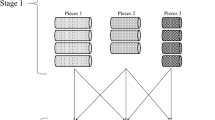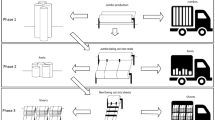Abstract
We study bin-packing and lot-sizing decisions in an integrated way. Such a problem appears in several manufacturing settings where items first need to be cut and next assembled into final products. One of the main novelties of this research is the modeling of the complex setup operations in the cutting process, which is modeled using a bin-packing formulation. More specifically, we consider the operation regarding the insertion or removal of the knives in the cutting process. Since this operation depends on the number of items cut in the current cutting process and in the previous one, the number of insertions and removals is sequence-dependent. The setups in the lot-sizing problem related to the production of the final products are also sequence-dependent. To deal with such a problem, two compact formulations are proposed. The sequence-dependent setups in the bin-packing problem are modeled in two different ways: based on known constraints from the literature, and based on the idea of micro-periods and a phantom cutting process. Due to the dependency in the setups decisions, the resulting formulations are mixed-integer nonlinear mathematical models. In order to deal with the sequence-dependent cutting and production setups, different polynomial-sized sets of subtour elimination constraints are employed to the coupled problem. A computational study is conducted in order to analyze the impact of the proposed approaches to model sequence-dependent setups, as well as the different subtour elimination strategies to solve the coupled bin-packing and lot-sizing problem, via an automatic-Benders decomposition algorithm.




Similar content being viewed by others
References
Aloisio A, Arbib C, Marinelli F (2011) Cutting stock with no three parts per pattern: work-in-process and pattern minimization. Discrete Optim 8(2):315–332
Arbib C, Marinelli F (2014) On cutting stock with due dates. Omega 46:11–20
Arbib C, Marinelli F, Pezzella F (2012) An lp-based tabu search for batch scheduling in a cutting process with finite buffers. Int J Prod Econ 136(2):287–296
Arbib C, Marinelli F, Ventura P (2016) One-dimensional cutting stock with a limited number of open stacks: bounds and solutions from a new integer linear programming model. Int Trans Oper Res 23(1–2):47–63
Armbruster M (2002) A solution procedure for a pattern sequencing problem as part of a one-dimensional cutting stock problem in the steel industry. Eur J Oper Res 141(2):328–340
Baldo TA, Santos MO, Almada-Lobo B, Morabito R (2014) An optimization approach for the lot sizing and scheduling problem in the brewery industry. Comput Ind Eng 72:58–71
Baumann P, Forrer S, Trautmann N (2015) Planning of a make-to-order production process in the printing industry. Flex Serv Manuf J 27:534–560
Bektaş T, Gouveia L (2014) Requiem for the Miller–Tucker–Zemlin subtour elimination constraints? Eur J Oper Res 236(3):820–832
Bennell JA, Lee LS, Potts CN (2013) A genetic algorithm for two-dimensional bin packing with due dates. Int J Prod Econ 145(2):547–560
Bonami P, Salvagnin D, Tramontani A (2019) Implementing automatic benders decomposition in a modern MIP solver. http://www.optimization-online.org/DB_FILE/2019/12/7506.pdf
Braga N, Alvez C, Macedo R, de Carvalho JV (2015) A model-based heuristic for the combined cutting stock and scheduling problem. Lect Notes Comput Sci 9156:409–505
Braga N, Alves C, Valério de Carvalho J (2016) Exact solution of combined cutting stock and scheduling problems. In: Fonseca RJ, Weber GW, Telhada J (eds) Computational management science. Springer International Publishing, pp 131–139
Conforti M, Wolsey LA (2019) Facet separation with one linear program. Math Program 178(1–2):361–380
Copil K, Wörbelauer M, Meyr H, Tempelmeier H (2017) Simultaneous lotsizing and scheduling problems: a classification and review of models. OR Spectrum 39(1):1–64
Dantzig G, Fulkerson R, Johnson S (1954) Solution of a large-scale traveling-salesman problem. J Oper Res Soc Am 2(4):393–410
de Araujo SA, Clark A (2013) A priori reformulations for joint rolling-horizon scheduling of materials processing and lot-sizing problem. Comput Ind Eng 65:557–585
Delorme M, Iori M, Martello S (2016) Bin packing and cutting stock problems: mathematical models and exact algorithms. Eur J Oper Res 255(1):1–20
Desrochers M, Laporte G (1991) Improvements and extensions to the Miller–Tucker–Zemlin subtour elimination constraints. Oper Res Lett 10(1):27–36
Drexl A, Kimms A (1997) Lot sizing and scheduling—survey and extensions. Eur J Oper Res 99(2):221–235
Dyckhoff H (1990) Cutting and packing a typology of cutting and packing problems. Eur J Oper Res 44(2):145–159
Fiorotto DJ, Jans R, de Araujo SA (2017) An analysis of formulations for the capacitated lot sizing problem with setup crossover. Comput Ind Eng 106:338–350
Fischetti M (2010) A note on the selection of benders’ cuts. Math Program 124(3):175–182
Foerster H, Wäscher G (1998) Simulated annealing for order spread minimization in sequencing cutting patterns. Eur J Oper Res 110(2):272–281
Gau T, Wäscher G (1995) Cutgen1: a problem generator for the standard one-dimensional cutting stock problem. Eur J Oper Res 84(3):572–579
Giannelos NF, Georgiadis MC (2001) Scheduling of cutting-stock processes on multiple parallel machines. Chem Eng Res Des 79(7):747–753
Gilmore PC, Gomory RE (1961) A linear programming approach to the cutting-stock problem. Oper Res 9(6):849–859
Gilmore PC, Gomory RE (1963) A linear programming approach to the cutting stock problem—part ii. Oper Res 11(6):863–888
Glock CH, Grosse EH, Ries JM (2014) The lot sizing problem: a tertiary study. Int J Prod Econ 155:39–51
Gouveia L, Pires JM (1999) The asymmetric travelling salesman problem and a reformulation of the Miller–Tucker–Zemlin constraints. Eur J Oper Res 112(1):134–146
Guimarães L, Klabjan D, Almada-Lobo B (2014) Modeling lotsizing and scheduling problems with sequence dependent setups. Eur J Oper Res 239(3):644–662
Hans E, van de Velde S (2011) The lot sizing and scheduling of sand casting operations. Int J Prod Res 49(9):2481–2499
IBM (2019) IBM CPLEX Optimizer (2019) CPLEX user’s manual. https://www.ibm.com/analytics/cplex-optimizer
Jans R, Degraeve Z (2004) Improved lower bounds for the capacitated lot sizing problem with setup times. Oper Res Lett 32(2):185–195
Jans R, Degraeve Z (2008) Modeling industrial lot sizing problems: a review. Int J Prod Res 46(6):1619–1643
Johnston RE, Sadinlija E (2004) A new model for complete solutions to one-dimensional cutting stock problems. Eur J Oper Res 153(1):176–183
Kantorovich LV (1960) Mathematical methods of organizing and planning production. Manag Sci 6(4):366–422
Karimi B, Ghomi SMTF, Wilson JM (2003) The capacitated lot sizing problem: a review of models and algorithms. Omega 31(5):365–378
Koo PH, Koh SG, Lee WS (2011) Simultaneous determination of lot size and production rate at capacity-constrained multiple-product systems. Flex Serv Manuf J 23:346–359
Li S (1996) Multi-job cutting stock problem with due dates and release dates. J Oper Res Soc 47(4):490–510
Madsen OBG (1988) An application of travelling-salesman routines to solve pattern-allocation problems in the glass industry. J Oper Res Soc 39(3):249–256
Mahdieh M, Clark A, Bijari M (2018) A novel flexible model for lot sizing and scheduling with non-triangular, period overlapping and carryover setups in different machine configurations. Flex Serv Manuf J 30:884–923
Marinelli F, Nenni ME, Sforza A (2007) Capacitated lot sizing and scheduling with parallel machines and shared buffers: a case study in a packaging company. Ann Oper Res 150(1):177–192
Martínez KP, Toso EAV, Morabito R (2016) Production planning in the molded pulp packaging industry. Comput Ind Eng 98:554–566
Matsumoto K, Umetani S, Nagamochi H (2011) On the one-dimensional stock cutting problem in the paper tube industry. J Sched 14(3):281–290
Melega GM, de Araujo SA, Jans R (2016) Comparison of mip models for the integrated lot-sizing and one-dimensional cutting stock problem. Pesqui Oper 36:167–196
Melega GM, de Araujo SA, Jans R (2018) Classification and literature review of integrated lot-sizing and cutting stock problems. Eur J Oper Res 271(1):1–19
Melega GM, de Araujo SA, Morabito R (2020) Mathematical model and solution approaches for integrated lot-sizing, scheduling and cutting stock problems. Ann Oper Res 295:695–736
Melega GM, de Araujo SA, Jans R, Morabito R (2021) Formulations and exact solution approaches for a coupled bin-packing and lot-sizing problem with sequence-dependent setups. GERAD - Group of Research in Decision Analysis, pp 1–37. https://www.gerad.ca/en/papers/G-2021-49
Meyr H (2000) Simultaneous lotsizing and scheduling by combining local search with dual reoptimization. Eur J Oper Res 120(2):311–326
Miller CE, Tucker AW, Zemlin RA (1960) Integer programming formulation of traveling salesman problems. J ACM 7(4):326–329
Pochet Y, Wolsey LA (1988) Lot-size models with backlogging: strong reformulations and cutting planes. Math Program 40(1–3):317–335
Reinertsen H, Vossen TW (2010) The one-dimensional cutting stock problem with due dates. Eur J Oper Res 201(3):701–711
Rinaldi F, Franz A (2007) A two-dimensional strip cutting problem with sequencing constraint. Eur J Oper Res 183(3):1371–1384
Sarin SC, Sherali HD, Bhootra A (2005) New tighter polynomial length formulations for the asymmetric traveling salesman problem with and without precedence constraints. Oper Res Lett 33(1):62–70
Thomas DJ, Griffin PM (1996) Coordinated supply chain management. Eur J Oper Res 94(1):1–15
Toscano A, Ferreira D, Morabito R (2019) A decomposition heuristic to solve the two-stage lot sizing and scheduling problem with temporal cleaning. Flex Serv Manuf J 31(1):142–173
Toso EAV, Morabito R, Clark AR (2009) Lot sizing and sequencing optimisation at an animal-feed plant. Comput Ind Eng 57(3):813–821
Trigeiro WW, Thomas LJ, McClain JO (1989) Capacitated lot sizing with setup times. Manag Sci 35(3):353–366
Valério de Carvalho JM (1999) Exact solution of bin-packing problems using column generation and branch-and-bound. Ann Oper Res 86:629–659
Valério de Carvalho JM (2002) Lp models for bin packing and cutting stock problems. Eur J Oper Res 141(2):253–273
Vickery SK, Markland RE (1986) Multi-stage lot-sizing in a serial production system. Int J Prod Res 24(3):517–534
Wäscher G, Haußner H, Schumann H (2007) An improved typology of cutting and packing problems. Eur J Oper Res 183(3):1109–1130
Wuttke DA, Heese HS (2018) Two-dimensional cutting stock problem with sequence dependent setup times. Eur J Oper Res 265(1):303–315
Yanasse HH, Lamosa MJP (2007) An integrated cutting stock and sequencing problem. Eur J Oper Res 183(3):1353–1370
Yuen BJ (1991) Heuristics for sequencing cutting patterns. Eur J Oper Res 55(2):183–190
Yuen BJ (1995) Improved heuristics for sequencing cutting patterns. Eur J Oper Res 87(1):57–64
Acknowledgements
This research was funded by the Conselho Nacional de Desenvolvimento Científico e Tecnológico (CNPq), Coordenação de Aperfeiçoamento de Pessoal de Nível Superior (CAPES) and the Fundação de Amparo à Pesquisa do Estado de São Paulo (FAPESP process n 2016/01860-1, 2018/19893-9, 2019/03302-4).
Author information
Authors and Affiliations
Corresponding author
Additional information
Publisher's Note
Springer Nature remains neutral with regard to jurisdictional claims in published maps and institutional affiliations.
Rights and permissions
Springer Nature or its licensor holds exclusive rights to this article under a publishing agreement with the author(s) or other rightsholder(s); author self-archiving of the accepted manuscript version of this article is solely governed by the terms of such publishing agreement and applicable law.
About this article
Cite this article
Melega, G.M., de Araujo, S.A., Jans, R. et al. Formulations and exact solution approaches for a coupled bin-packing and lot-sizing problem with sequence-dependent setups. Flex Serv Manuf J 35, 1276–1312 (2023). https://doi.org/10.1007/s10696-022-09464-9
Accepted:
Published:
Issue Date:
DOI: https://doi.org/10.1007/s10696-022-09464-9




